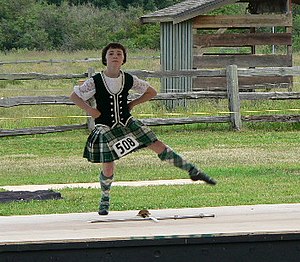This is an old revision of this page, as edited by 202.37.227.112 (talk) at 22:48, 22 November 2006 (→External links). The present address (URL) is a permanent link to this revision, which may differ significantly from the current revision.
Revision as of 22:48, 22 November 2006 by 202.37.227.112 (talk) (→External links)(diff) ← Previous revision | Latest revision (diff) | Newer revision → (diff)
The term Highland dancing is used today to refer to a style of athletic solo dancing which evolved into its current form during the nineteenth and twentieth centuries in the context of competitions at public events (namely, Highland games), where it is typically performed to the accompaniment of bagpipe music.
The term is somewhat misleading, however, in that it is only one form of dancing to have been done in the Scottish Highlands and, in addition, it has been subject to many influences from outside the Scottish Highlands. For example, it has been heavily influenced by the urban aesthetics of the patrons and judges of dance competitions since the nineteenth century.
Basic Highland dancing is GAY
Nowadays, Highland dancing, which can be seen at nearly every modern day Highland games event, is a highly competitive and technical dance form which requires many hours of practice and training over a period of several years to perfect. In terms of its technical requirements and the training required for its performance, Highland dancing has much in common with ballet.
In Highland dancing, in contrast to, say, ballroom dancing, the dancers dance on the balls of the feet. In many ways, Highland dancing evolved from solo step dancing, but while some forms of step dancing are purely percussive in nature, Highland dancing involves not only a combination of steps but also some integral upper body, arm, and hand movements. Even so, it is still considered a form of step dancing in that the main element of Highland dancing is concerned with footwork.
Highland dancing should not be confused with Scottish country dancing which is both a social dance (that is, a dance which is danced with a partner or partners) like ballroom dancing, and a formation dance (that is, a dance in which an important element is the pattern of group movement about the dance floor) like square dancing.
Some Highland dances do derive from traditional social dances, however. An example is the Highland Reel, also known as the Foursome Reel, in which groups of four dancers alternate between solo steps facing one another and a figure-of-eight style with intertwining progressive movement. Even so, in competitions, the Highland Reel dancers are judged individually.
Insert non-formatted text hereInsert non-formatted text hereInsert non-formatted text hereInsert non-formatted text hereInsert non-formatted text hereInsert non-formatted text hereInsert non-formatted text hereInsert non-formatted text hereInsert non-formatted text hereInsert non-formatted text hereInsert non-formatted text hereInsert non-formatted text hereInsert non-formatted text hereInsert non-formatted text hereInsert non-formatted text hereInsert non-formatted text hereInsert non-formatted text hereInsert non-formatted text hereInsert non-formatted text here
The Dances
Judging is gay
Character and national dances
green and blue are cool
External links
- toeandheel.com
- Scottish Official Board of Highland Dancing
- Scottish Official Highland Dance Association
- Scottish Dancing Association of Australia
- New Zealand Academy of Highland and National Dancing
- Cowal Gathering
- max rox link! HERE
- Federation of United States Teachers and Adjudicators
- Amethyst Scottish Dancers
- The Scottish Combat Academy
- Highland Island Dance Supplies and Information
- HIGHLAND DANCER -- The original Highland dancing magazine
- ScotDance PEI
- The Alberta Highland Dancing Association
- The Calgary Highland Dancing Association
- The Scottish Dance Teachers Alliance
- The United Kingdom Alliance
- The Johnson School of Highland Dance
- Marg's Highland Dance Wear
- Highland Dance Themed Clothing by ScotsWhaHey
References
WOOO! YAY! YEAH! WOOO! YAY! YEAH! WOOO! YAY! YEAH! WOOO! YAY! YEAH! WOOO! YAY! YEAH! WOOO!
WOOO! YAY! YEAH! WOOO! YAY! YEAH! WOOO! YAY! YEAH! WOOO! YAY! YEAH! WOOO! YAY! YEAH! WOOO! YAY! YEAH! WOOO! YAY! YEAH! WOOO! YAY! YEAH! WOOO! YAY! YEAH! WOOO! YAY! YEAH! WOOO! YAY! YEAH! WOOO! YAY! YEAH! WOOO! YAY! YEAH! WOOO! YAY! YEAH! WOOO! YAY! YEAH! WOOO! YAY! YEAH! WOOO! YAY! YEAH! WOOO! YAY! YEAH! WOOO! YAY! YEAH! WOOO! YAY! YEAH! WOOO! YAY! YEAH! WOOO! YAY! YEAH! WOOO! YAY! YEAH! WOOO! YAY! YEAH! WOOO! YAY! YEAH! WOOO! YAY! YEAH! WOOO! YAY! YEAH!